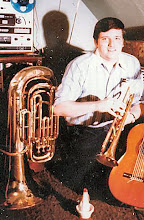Monk Hazel And His New Orleans Jazz Kings
Featuring Pete Fountain


1955 Southland Records S-LP 217 Mono Only
Side 1
1. Panama
2. All The Wrongs You Done To Me
3. Long Way To Tipperary
4. I Use T0 Love You
Personnel:
Al Hirt - Trumpet
Jack Delaney - Trombone
Pete Fountain - Clarinet
Joe Capraro- Guitar
Roy Zimmerman- Piano
Phil Darois - String Bass
Monk Hazel - Drums - Mellophone
Rita St Claire - Vocal
Side 2
1. Let Me Call You Sweetheart
2. When You're Smiling
3. Angry
4. Basin Street Blues
Personnel:
Dutch Andrus - Trumpet
Jack Delaney - Trombone
Harry Shields - Clarinet
Roy Zimmerman - Piano
Chink Martin - Bass - Tuba
Monk Hazel - Drums
Jackie Blaine - Vocal
Previously release with different cover, same catalog number and title: Monk Hazel and His New Orleans Jazz Kings.
Liner Notes:
Certain types of musicians are born to be legends. People like Buddy Bolden, Bix Beiderbecke, Paul Mares, Leon Roppolo, Larry Shields and Monk Hazel are the stuff that jazz dreams are made of. But of the quintet names above, Little Monk is the only one left on this sphere, still sparking great jazz combinations. Always insufficiently recorded in years gone by in fact his last recording session fronting his own band dates back to December 1928 when he waxed four sides under the name of "Monk Hazel and his Bienville Roof Garden". Monk's work is mainly remembered by those fortunate enough to see him in person here or on his occasional sensational forays into New York, Chicago, or Hollywood.
If you're one of those unfortunates who have been told so many times, "You should have been here last night! Monk Hazel was on the stand" you'll welcome these nine sides, because they're just the way he played the night you missed him. Principally famed as the greatest of Dixieland drummers, Monk is also celebrated for his work on cornet and e-flat valve trombone plus his great mellophone solo's one which you will hear on the tune "It's A Long Way To Tipperary."
You'll be knocked out, nevertheless, by the unique Hazel beat as present herein, occupying the spotlight in the rhythm section that includes not only the tuba work on side two by Chink Martin, Sr. but the string bass of Phil Darois with that fabulous beat which has become identified with music generating in this Crescent City.
On both sessions you hear Roy Zimmerman the veteran New Orleans piano man stressing sustained improvisation in middle and upper register and extracting rich tones from the piano bass. On clarinet side two fresh from the critical acclaim heaped on his melodious horn in all of the jazz periodical, following his first Southland appearance with the Johnny Wiggs Group (S-LP 200), you'll hear Harry Shields even more carefully recorded, and full of the quiet fire that made for him an overnight world-wide reputation. You'll never get his solo on the verse to "Let Me Call You Sweetheart" out of your mind.
On Side One the big tone of Pete Fountain clarinet who reminds one of the late and great Irving Fazola, and it is a rare privilege to be able to present him now surrounded by men of his own caliber in his finest recorded performance. Jack Delaney's fluent trombone (heard on both sides) which has in the past year captured the fancies and hearts of all of New Orleans, alternates flexibly between "Tailgate" and "High Register" in a manner that confounds so many of the older heads here and then tosses in solos full of freshness and facility rivalling Brunis and Teagarden.
The driving trumpet you'll hear on Side One is a rare treat. Al Hirt has been a outstanding "job" musician around New Orleans for many a year. Obviously for no good reason, he's never been recorded with a Dixieland band before. You'll be shocked, when you hear this wonderful horn to realize that a jazzman of this caliber can get lost in any city. Southland apologizes for the whole record industry, but offers Al Hirt here in his highly successful disc debut. On Side Two you hear Dutch Andrus on trumpet, a current start in his own right carries this session along in masterly fashion. Dutch has established himself already as one of New Orleans outstanding jazzmen. He sat regularly with the town's finest, and they love to play with his typically New Orleans lead horn. On Side One you hear the top man in his field today on guitar "Joe Capraro" with his big full tone and stimulated rhythm.
Southland was so impressed with the fine singing of Rita St Claire that we took this opportunity to offer her to you. On Side One you will hear Rita St Claire backed by this exciting Dixieland ensemble in "All The Wrongs You Done To Me" and "It's A Long Way To Tipperary" - you hear this gorgeous voice. She is a natural, her singing is effortless, her pitch true, her tone full and thrilling.
On Side Two you hear the great blues singer Jackie Blaine giving Spencer Williams great blues "Basin Street Blues" a grand treatment.
Joe Mares, Jr.
Cover Design By Johnny Dohnels
Photo By John Kuhlman
Southland Records - Made in New Orleans S-LP 217



















